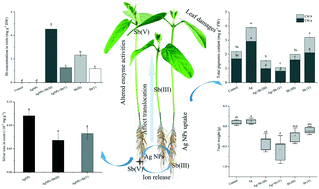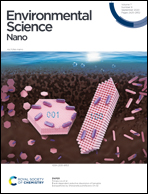Mutual effects of silver nanoparticles and antimony(iii)/(v) co-exposed to Glycine max (L.) Merr. in hydroponic systems: uptake, translocation, physiochemical responses, and potential mechanisms†
Abstract
Antimony (Sb) is a non-necessary metallic element to plants, which can get largely accumulated by terrestrial plants and potentially invade the food chain, leading to concerns with regard to food safety. Considering the redox properties and widespread presence of silver nanoparticles (Ag NPs), the current study attempted to shed light on the mutual effects of Ag NPs and Sb(III)/(V) on their uptake, accumulation, and corresponding biochemical effects in Glycine max (L.) Merr. (soybean). The seedling matrix was formulated by the batch exposure of Sb(III)/(V) with/or synthesized Ag NPs (∼10 nm). Significant mutual impacts were detected with the co-presence of Ag NPs and Sb on their uptake and translocation in soybean tissues. Ag NPs stimulated the accumulation of Sb(III) in roots, while reduced its translocation into leaves. In contrast, Sb(V) uptake in tissues was improved by the presence of Ag NPs. In addition, the combined exposure of Ag NPs with Sb(V) led to significantly higher Ag accumulation in tissues as compared to other treatments. In comparison to single treatments, the co-exposure of Ag NPs with Sb(V) resulted in higher impacts on the pigment contents, enzyme activities, and lipid peroxidation. However, the combination of Ag NPs with Sb(III) led to higher reactive oxygen species (ROS) in roots. The altered accumulation of Ag and Sb in soybeans and corresponding biochemical regulations upon different amendments could be attributed to the synergistic physical, chemical, and biological interactions in the soybean rhizosphere and tissues. To the best of our knowledge, this is the first evidence of nanoparticle interactions with Sb species during their uptake and accumulation in plants, which could provide the necessary impetus for investigating the bioaccumulation and physiochemical influences mediated by the co-exposure of Sb species and engineered nanoparticles (ENPs) in plants.



 Please wait while we load your content...
Please wait while we load your content...